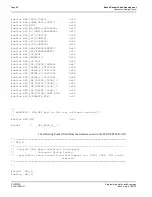
Page 86
Epson Research and Development
Vancouver Design Center
S1D13505
Programming Notes and Examples
X23A-G-003-07
Issue Date: 01/02/05
** The background must be set to transparent.
*/
seInitCursor(Device);
seDrawCursorRect(Device, 0, 0, 63, 63, 2, TRUE);
/*
** Set the first user definable color to black and
** the second user definable color to white.
*/
seSetCursorColor(Device, 0, 0);
seSetCursorColor(Device, 1, 0xFFFFFFFF);
/*
** Draw a hollow rectangle around the cursor and move
** the cursor to 101,101.
*/
seDrawCursorRect(Device, 0, 0, 63, 63, 1, FALSE);
seMoveCursor(Device, 101, 101);
exit(0);
}
12.1.2 Sample code without using the S1D13505 HAL API
/*
**===========================================================================
** INIT1355.C - sample code demonstrating the initialization of the SED1355.
** Beta release 2.0 98-10-29
**
** The code in this example will perform initialization to the following
** specification:
**
** - 640 x 480 dual 16-bit color passive panel.
** - 75 Hz frame rate.
** - 8 BPP (256 colors).
** - 33 MHz input clock.
** - 2 MB of 60 ns EDO memory.
**
** *** This is sample code only! ***
** This means:
** 1) Generic C is used. I assume that pointers can access the
** relevant memory addresses (this is not always the case).
** i.e. using the 1355B0B card on an x86 16 bit platform will require
** changes to use a DOS extender to access memory and registers.
** 2) Register setup is done with discrete writes rather than being
** table driven. This allows for clearer commenting. A real program
** would probably store the register settings in an array and loop
** through the array writing each element to a control register.
















































